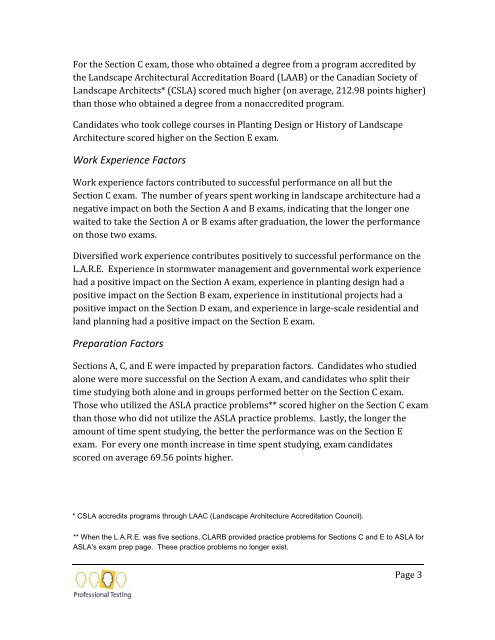Determinants-of-Success-Report-Final-Report-Executive-Summary-footnotes
Determinants-of-Success-Report-Final-Report-Executive-Summary-footnotes
Determinants-of-Success-Report-Final-Report-Executive-Summary-footnotes
You also want an ePaper? Increase the reach of your titles
YUMPU automatically turns print PDFs into web optimized ePapers that Google loves.
For the Section C exam, those who obtained a degree from a program accredited by<br />
the Landscape Architectural Accreditation Board (LAAB) or the Canadian Society <strong>of</strong><br />
Landscape Architects* (CSLA) scored much higher (on average, 212.98 points higher)<br />
than those who obtained a degree from a nonaccredited program.<br />
Candidates who took college courses in Planting Design or History <strong>of</strong> Landscape<br />
Architecture scored higher on the Section E exam.<br />
Work Experience Factors<br />
Work experience factors contributed to successful performance on all but the<br />
Section C exam. The number <strong>of</strong> years spent working in landscape architecture had a<br />
negative impact on both the Section A and B exams, indicating that the longer one<br />
waited to take the Section A or B exams after graduation, the lower the performance<br />
on those two exams.<br />
Diversified work experience contributes positively to successful performance on the<br />
L.A.R.E. Experience in stormwater management and governmental work experience<br />
had a positive impact on the Section A exam, experience in planting design had a<br />
positive impact on the Section B exam, experience in institutional projects had a<br />
positive impact on the Section D exam, and experience in large‐scale residential and<br />
land planning had a positive impact on the Section E exam.<br />
Preparation Factors<br />
Sections A, C, and E were impacted by preparation factors. Candidates who studied<br />
alone were more successful on the Section A exam, and candidates who split their<br />
time studying both alone and in groups performed better on the Section C exam.<br />
Those who utilized the ASLA practice problems** scored higher on the Section C exam<br />
than those who did not utilize the ASLA practice problems. Lastly, the longer the<br />
amount <strong>of</strong> time spent studying, the better the performance was on the Section E<br />
exam. For every one month increase in time spent studying, exam candidates<br />
scored on average 69.56 points higher.<br />
Page 3


